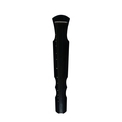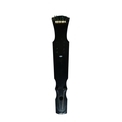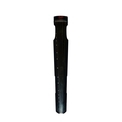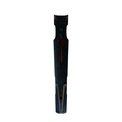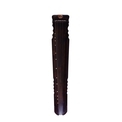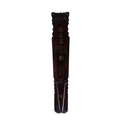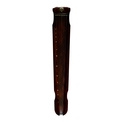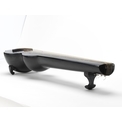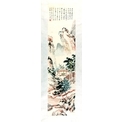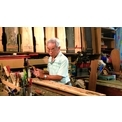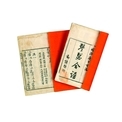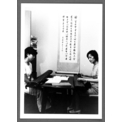Tools used in the fourth step of qin making process
Tools and materials used in the fourth step of qin making process – fitting:
(1)Tiger tongue rasp – for polishing the sides, refining rounded areas and decorating hardwood accessories
(2)Horse teeth rasp – thicker than the tiger tongue rasp, used for conditioning on a larger scale
(3)Hardwood accessories – peg shields, Mount Yue, peg pond board, goose feet, dragon gum and a pair of ceremonial caps (right to left)
(4)Abalone shell – can be used as the material for the markers
(5)The 13 markers – the seventh marker, as it sits in the middle, is slightly larger. The other markers on each side are successively smaller than the previous one
(6)Flour – for mixing with raw lacquer to create an adhesive
(7)Animal gum – for use as an adhesive after being melted in a double boiler
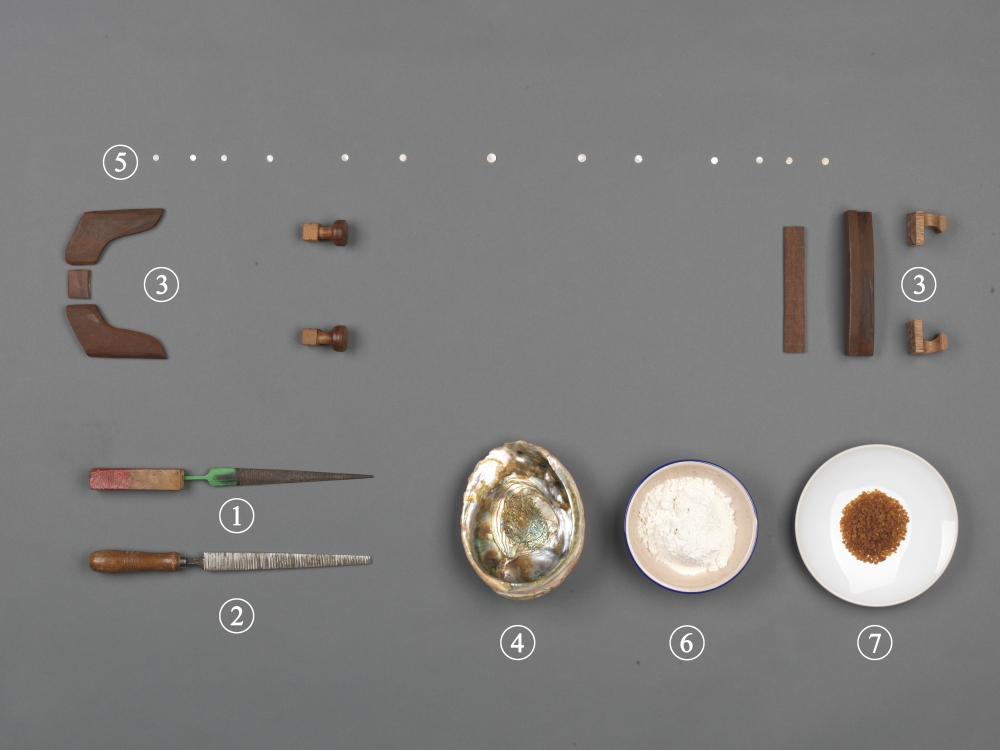
| Date | 2013 |
| Material Type | Image |
| Collection | The Legend of Silk and Wood: A Hong Kong Qin Story |
| Source | Intangible Cultural Heritage Office and Hong Kong Heritage Museum |
| Repository | Intangible Cultural Heritage Office |
| Note to Copyright | Permission for use in Hong Kong Memory is given by Intangible Cultural Heritage Office and Hong Kong Heritage Museum |
| Accession No. | lcs-hkqs-0109 |
Tools used in the fourth step of qin making process
Tools and materials used in the fourth step of qin making process – fitting:
(1)Tiger tongue rasp – for polishing the sides, refining rounded areas and decorating hardwood accessories
(2)Horse teeth rasp – thicker than the tiger tongue rasp, used for conditioning on a larger scale
(3)Hardwood accessories – peg shields, Mount Yue, peg pond board, goose feet, dragon gum and a pair of ceremonial caps (right to left)
(4)Abalone shell – can be used as the material for the markers
(5)The 13 markers – the seventh marker, as it sits in the middle, is slightly larger. The other markers on each side are successively smaller than the previous one
(6)Flour – for mixing with raw lacquer to create an adhesive
(7)Animal gum – for use as an adhesive after being melted in a double boiler

| Date | 2013 |
| Material Type | Image |
| Collection | The Legend of Silk and Wood: A Hong Kong Qin Story |
| Source | Intangible Cultural Heritage Office and Hong Kong Heritage Museum |
| Repository | Intangible Cultural Heritage Office |
| Note to Copyright | Permission for use in Hong Kong Memory is given by Intangible Cultural Heritage Office and Hong Kong Heritage Museum |
| Accession No. | lcs-hkqs-0109 |
Tools used in the fourth step of qin making process
Tools and materials used in the fourth step of qin making process – fitting:
(1)Tiger tongue rasp – for polishing the sides, refining rounded areas and decorating hardwood accessories
(2)Horse teeth rasp – thicker than the tiger tongue rasp, used for conditioning on a larger scale
(3)Hardwood accessories – peg shields, Mount Yue, peg pond board, goose feet, dragon gum and a pair of ceremonial caps (right to left)
(4)Abalone shell – can be used as the material for the markers
(5)The 13 markers – the seventh marker, as it sits in the middle, is slightly larger. The other markers on each side are successively smaller than the previous one
(6)Flour – for mixing with raw lacquer to create an adhesive
(7)Animal gum – for use as an adhesive after being melted in a double boiler

| Date | 2013 |
| Material Type | Image |
| Collection | The Legend of Silk and Wood: A Hong Kong Qin Story |
| Source | Intangible Cultural Heritage Office and Hong Kong Heritage Museum |
| Repository | Intangible Cultural Heritage Office |
| Note to Copyright | Permission for use in Hong Kong Memory is given by Intangible Cultural Heritage Office and Hong Kong Heritage Museum |
| Accession No. | lcs-hkqs-0109 |
Tools used in the fourth step of qin making process
Tools and materials used in the fourth step of qin making process – fitting:
(1)Tiger tongue rasp – for polishing the sides, refining rounded areas and decorating hardwood accessories
(2)Horse teeth rasp – thicker than the tiger tongue rasp, used for conditioning on a larger scale
(3)Hardwood accessories – peg shields, Mount Yue, peg pond board, goose feet, dragon gum and a pair of ceremonial caps (right to left)
(4)Abalone shell – can be used as the material for the markers
(5)The 13 markers – the seventh marker, as it sits in the middle, is slightly larger. The other markers on each side are successively smaller than the previous one
(6)Flour – for mixing with raw lacquer to create an adhesive
(7)Animal gum – for use as an adhesive after being melted in a double boiler

| Date | 2013 |
| Material Type | Image |
| Collection | The Legend of Silk and Wood: A Hong Kong Qin Story |
| Source | Intangible Cultural Heritage Office and Hong Kong Heritage Museum |
| Repository | Intangible Cultural Heritage Office |
| Note to Copyright | Permission for use in Hong Kong Memory is given by Intangible Cultural Heritage Office and Hong Kong Heritage Museum |
| Accession No. | lcs-hkqs-0109 |
Tools used in the fourth step of qin making process
Tools and materials used in the fourth step of qin making process – fitting:
(1)Tiger tongue rasp – for polishing the sides, refining rounded areas and decorating hardwood accessories
(2)Horse teeth rasp – thicker than the tiger tongue rasp, used for conditioning on a larger scale
(3)Hardwood accessories – peg shields, Mount Yue, peg pond board, goose feet, dragon gum and a pair of ceremonial caps (right to left)
(4)Abalone shell – can be used as the material for the markers
(5)The 13 markers – the seventh marker, as it sits in the middle, is slightly larger. The other markers on each side are successively smaller than the previous one
(6)Flour – for mixing with raw lacquer to create an adhesive
(7)Animal gum – for use as an adhesive after being melted in a double boiler

| Date | 2013 |
| Material Type | Image |
| Collection | The Legend of Silk and Wood: A Hong Kong Qin Story |
| Source | Intangible Cultural Heritage Office and Hong Kong Heritage Museum |
| Repository | Intangible Cultural Heritage Office |
| Note to Copyright | Permission for use in Hong Kong Memory is given by Intangible Cultural Heritage Office and Hong Kong Heritage Museum |
| Accession No. | lcs-hkqs-0109 |
Tools used in the fourth step of qin making process
Tools and materials used in the fourth step of qin making process – fitting:
(1)Tiger tongue rasp – for polishing the sides, refining rounded areas and decorating hardwood accessories
(2)Horse teeth rasp – thicker than the tiger tongue rasp, used for conditioning on a larger scale
(3)Hardwood accessories – peg shields, Mount Yue, peg pond board, goose feet, dragon gum and a pair of ceremonial caps (right to left)
(4)Abalone shell – can be used as the material for the markers
(5)The 13 markers – the seventh marker, as it sits in the middle, is slightly larger. The other markers on each side are successively smaller than the previous one
(6)Flour – for mixing with raw lacquer to create an adhesive
(7)Animal gum – for use as an adhesive after being melted in a double boiler

| Date | 2013 |
| Material Type | Image |
| Collection | The Legend of Silk and Wood: A Hong Kong Qin Story |
| Source | Intangible Cultural Heritage Office and Hong Kong Heritage Museum |
| Repository | Intangible Cultural Heritage Office |
| Note to Copyright | Permission for use in Hong Kong Memory is given by Intangible Cultural Heritage Office and Hong Kong Heritage Museum |
| Accession No. | lcs-hkqs-0109 |
Tools used in the fourth step of qin making process
Tools and materials used in the fourth step of qin making process – fitting:
(1)Tiger tongue rasp – for polishing the sides, refining rounded areas and decorating hardwood accessories
(2)Horse teeth rasp – thicker than the tiger tongue rasp, used for conditioning on a larger scale
(3)Hardwood accessories – peg shields, Mount Yue, peg pond board, goose feet, dragon gum and a pair of ceremonial caps (right to left)
(4)Abalone shell – can be used as the material for the markers
(5)The 13 markers – the seventh marker, as it sits in the middle, is slightly larger. The other markers on each side are successively smaller than the previous one
(6)Flour – for mixing with raw lacquer to create an adhesive
(7)Animal gum – for use as an adhesive after being melted in a double boiler

| Date | 2013 |
| Material Type | Image |
| Collection | The Legend of Silk and Wood: A Hong Kong Qin Story |
| Source | Intangible Cultural Heritage Office and Hong Kong Heritage Museum |
| Repository | Intangible Cultural Heritage Office |
| Note to Copyright | Permission for use in Hong Kong Memory is given by Intangible Cultural Heritage Office and Hong Kong Heritage Museum |
| Accession No. | lcs-hkqs-0109 |
Tools used in the fourth step of qin making process
Tools and materials used in the fourth step of qin making process – fitting:
(1)Tiger tongue rasp – for polishing the sides, refining rounded areas and decorating hardwood accessories
(2)Horse teeth rasp – thicker than the tiger tongue rasp, used for conditioning on a larger scale
(3)Hardwood accessories – peg shields, Mount Yue, peg pond board, goose feet, dragon gum and a pair of ceremonial caps (right to left)
(4)Abalone shell – can be used as the material for the markers
(5)The 13 markers – the seventh marker, as it sits in the middle, is slightly larger. The other markers on each side are successively smaller than the previous one
(6)Flour – for mixing with raw lacquer to create an adhesive
(7)Animal gum – for use as an adhesive after being melted in a double boiler

| Date of Death | 2013 |
| Material Type | Image |
| Collection | The Legend of Silk and Wood: A Hong Kong Qin Story |
| Source | Intangible Cultural Heritage Office and Hong Kong Heritage Museum |
| Repository | Intangible Cultural Heritage Office |
| Note to Copyright | Permission for use in Hong Kong Memory is given by Intangible Cultural Heritage Office and Hong Kong Heritage Museum |
| Accession No. | lcs-hkqs-0109 |
Tools used in the fourth step of qin making process
Tools and materials used in the fourth step of qin making process – fitting:
(1)Tiger tongue rasp – for polishing the sides, refining rounded areas and decorating hardwood accessories
(2)Horse teeth rasp – thicker than the tiger tongue rasp, used for conditioning on a larger scale
(3)Hardwood accessories – peg shields, Mount Yue, peg pond board, goose feet, dragon gum and a pair of ceremonial caps (right to left)
(4)Abalone shell – can be used as the material for the markers
(5)The 13 markers – the seventh marker, as it sits in the middle, is slightly larger. The other markers on each side are successively smaller than the previous one
(6)Flour – for mixing with raw lacquer to create an adhesive
(7)Animal gum – for use as an adhesive after being melted in a double boiler

| Date | 2013 |
| Material Type | Image |
| Collection | The Legend of Silk and Wood: A Hong Kong Qin Story |
| Source | Intangible Cultural Heritage Office and Hong Kong Heritage Museum |
| Note to Copyright | Permission for use in Hong Kong Memory is given by Intangible Cultural Heritage Office and Hong Kong Heritage Museum |
| Accession No. | lcs-hkqs-0109 |
Tools used in the fourth step of qin making process
Tools and materials used in the fourth step of qin making process – fitting:
(1)Tiger tongue rasp – for polishing the sides, refining rounded areas and decorating hardwood accessories
(2)Horse teeth rasp – thicker than the tiger tongue rasp, used for conditioning on a larger scale
(3)Hardwood accessories – peg shields, Mount Yue, peg pond board, goose feet, dragon gum and a pair of ceremonial caps (right to left)
(4)Abalone shell – can be used as the material for the markers
(5)The 13 markers – the seventh marker, as it sits in the middle, is slightly larger. The other markers on each side are successively smaller than the previous one
(6)Flour – for mixing with raw lacquer to create an adhesive
(7)Animal gum – for use as an adhesive after being melted in a double boiler

| Date | 2013 |
| Material Type | Image |
| Collection | The Legend of Silk and Wood: A Hong Kong Qin Story |
| Source | Intangible Cultural Heritage Office and Hong Kong Heritage Museum |
| Repository | Intangible Cultural Heritage Office |
| Note to Copyright | Permission for use in Hong Kong Memory is given by Intangible Cultural Heritage Office and Hong Kong Heritage Museum |
| Accession No. | lcs-hkqs-0109 |
Copyright © 2012 Hong Kong Memory


